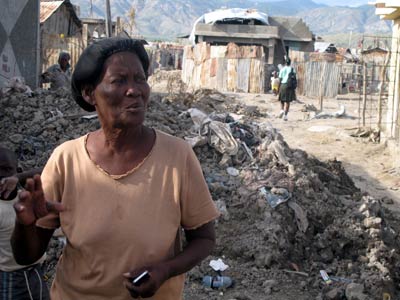 |
Roopa Rakshit shares the outcomes and take-home messages that emerged during discussions at a Bangkok seminar on linking disaster risk reduction and climate change adaptation. |
| The author is Senior Knowledge Management Officer for the Regional Climate Change Adaptation Knowledge Platform for Asia at the United Nations Environment Programme Regional Resource Center for Asia and the Pacific in Bangkok, Thailand. | |
The Regional Climate Change Adaptation Knowledge Platform for Asia held the first of a series of bi-monthly Knowledge Sharing and Learning Seminars on March 31st 2010 in Bangkok, Thailand. The seminar provided an informal setting that enabled over 70 adaptation, development and environment practitioners, representatives of national, regional and international organizations from 38 organizations based in Bangkok, to meet, network, share and learn from discussion and debate.
The theme was linkages between disaster risk reduction and climate change adaptation. Ensuing deliberations with active participation from the floor focused on four guided questions:
- What is the difference between climate change adaptation and disaster risk reduction?
- Adaptation and disaster risk reduction: two distinct communities?
- What are the arguments for stronger linkages?
- What is the way forward? How do we organize ourselves?
The linkages between climate change adaptation, disaster risk reduction and ecosystems are increasingly being recognized. It is generally understood that ecosystems help reduce natural hazard risks, including those exacerbated by climate change. The discussion revolved around how much evidence there is around the world and if there is a need for more evidence on ecosystems protecting communities from climate change and natural disasters. Participants felt that it was important to consider and note that the pace of recovery of ecosystems is coupled with that of the local community and to address not only the linkages between disaster risk reduction and climate change adaptation but also climate change mitigation options.
For sustainable development, the importance of linkages between disaster risk reduction and climate change adaptation is paramount and was duly recognized during the discussion. Several issues were discussed. For example, "business as usual" for ongoing development is no longer an option and early action needs to be taken with vulnerability addressed in public policy strategies. In that regard, linkages to food security and climate change mitigation were highlighted as ways towards sustainable development.
In some countries, there is evidence that certain types of development (for example, construction of roads) lead to increased vulnerability and potential disasters affecting the areas where the informal sector is concentrated (landslides and floods in Mexico were cited). In many cases, urbanization is occurring too quickly, which, in the coastal zone, coupled with sea-level rise, can lead to more disasters. Irrespective of a country's developmental situation and process, most important for a country to strategize climate change adaptation and disaster risk reduction effectively is to have political stability, commitment from leaders and community participation - all governance issues.
| Climate change adaptation | Disaster risk reduction | |
|---|---|---|
| Attributes | Policy relevant Moving toward public policy choices, including at local level as disaster risk reduction Following the global funding mandate |
Action based (also policy relevant) Community-focused (long history of experiences at community levels), also requiring national policies |
| Strengths | Can provide policy-envelope, including climate
change scenario-based choices for development
planning Can provide local and national government with problem statements toward modalities and planning of economic development |
Can maintain communities' commitment to
adapt short-term coping practices through existing
resources Also needs national policy development and integration into sectoral policies |
| Weaknesses | Downscaled data on projected climate change and its impacts at community levels are uncertain | Cannot rely on private funding or overseas
development assistance The mechanism of securing public budget funding is not in place for disaster risk reduction at community levels |
| Challenges | Bringing long-term adaptation planning into communities - communities' responses are most often short-term and protect immediate needs | Mainstreaming disaster risk reduction into
development planning at the national level Disaster risk reduction is mainly to be mainstreamed into climate change adaptation as a first priority in order to facilitate adaptation in all other sectors (agriculture, health, water, coastal zone management, and so on) |
Seminar participants discussed action that they could take in the context of their own work. While linkages between the sectors are established, a certain onus lies with the climate change adaptation and disaster risk reduction communities of practitioners.
Climate change adaptation practitioners can play a role in further enabling and facilitating policy dialogues between the climate adaptation community and policy processes related to the Hyogo Framework for Action. They can support analysis and interpretation of risk issues in non-environmental government departments (in all sectors, as all are exposed to natural hazards and, if vulnerable, these can lead to disasters). It is also important that they share concrete examples and case studies of adaptation initiatives with disaster risk reduction colleagues, using more narratives and examples and avoiding conceptual jargon. Finally, adaptation practitioners can facilitate co-financing between adaptation and disaster risk reduction projects and conduct economic valuation of adaptation impacts in particular countries and sectors, sharing information with disaster risk reduction practitioners.
Likewise, disaster risk reduction practitioners can conduct more scenario planning exercises, looking forward rather than applying a planning envelope that is based on historic hazard occurrences. They can support analysis and interpretations of risks in non-disaster management government departments, promote a multi-hazard approach rather than single-hazard to early warning systems (these need to be hazard-specific but they can be developed, policy-wise, as a disaster risk reduction component within a multi-hazard approach) and support systematic management and analysis of hydro-meteorological data. Disaster risk reduction practitioners need to get acquainted and understand better climate change and its potential impacts (for example, as climate change increases the intensity and frequency of hazards happening in the same areas as today or creates hazards happening in areas where they didn't happen before). Most importantly, they need to appreciate the potential impact of new hazards such as the melting of glaciers, glacial lake outbreak floods and impacts related to sea-level and ocean temperature rise. They should be aware of the Special Report on Managing Risk of Extreme Events by the Intergovernmental Panel on Climate Change, to be finalized in 2011.
Seminar participants also considered the way forward. Information needs and availability and communications issues proved a major theme.
It was concluded that the challenges of data availability must not be considered an obstacle to addressing the needs of climate risk management. The fact remains, however, that there are information gaps. It is important to acknowledge the inherent uncertainties within the data and models while communicating information on risks or decisions that lead to planning and policies. An adequate approach would be needed to overcome the lack of data and this will have bearing on uncertainty trade-offs while simultaneously continuing to implement actions to strengthen the resilience of local communities and reduce vulnerabilities.
Strategies for climate change adaptation cannot be achieved without understanding today's risks, traditionally available in the form of disaster risk reduction, for which Disaster Risk Management is the main tool. While addressing disaster risk reduction, there exists a clear gap in methods and guidelines for relevant and appropriate probabilistic risk assessment as baseline elements that eventually form a basis to climate risk management and adaptation. Seminar participants recognized that today's experiences of adaptation are limited to good coping measures rather than full and comprehensive adaptation strategies. Therefore, an entry point with methods and guidelines may work well in providing both technical and technological need assessment across climate-sensitive sectors. Not only is coping necessary but also long-term adjustments; short-term coping is needed but it is essential to do it with a long-term perspective.
 |
|
House demolished by mud slide during tropical
storm, Gonaïves, Haiti, 2008
© EC/ECHO/Raphaël Brigandi |
Climate change adaptation/disaster risk reduction stakeholder mapping is recommended to generate an inventory of key players, initiatives, products, and so on. This will help organize the climate change adaptation and disaster risk reduction communities. Common strategies and plans need to be developed at all levels (national and local) for addressing climate change adaptation with clear risk reduction approaches in all sectors.
Even when information on future climate risks is available, the challenge lies in how to unpack the information, how information can be interpreted for decision-makers and how to improve communication strategies to convince decision-makers to conduct long-term planning and boost understanding of climate change adaptation through strategic communication for its effective use and applications at various levels.
Climate change is not only a risk for communities but also an opportunity to engage investors. For example, it provides an opportunity for the private sector to be innovative and build the market for new demand (emerging out of climatic changes across the sectors) beyond Corporate Social Responsibilities, not only to build the clientele but also to meet the demand by making it affordable.
It was considered essential to improve communication with the general public by making abstract terminologies concrete and creating common messages and enhancing understanding. Decision making and policy making should be understandable and transparent to the people for whom it is made. The media, with adequate information and training, can play a crucial role in disseminating climate change adaptation information to a wider audience.
Improving communication strategies to interpret data and information for decision makers to conduct long-term planning and knowledge-based solutions is an urgent call, as is ensuring local governments enhance their understanding of climate change adaptation and disaster risk reduction through strategic communications. Nevertheless, the need to improve communication with the general public on the need to reduce risk and vulnerability to natural hazards is the first urgent step in adapting to climate change.
The Regional Climate Change Adaptation Knowledge Platform for Asia will play a significant role in promoting institutional mechanisms to support decision-making processes for managing risks at all levels (Hyogo Framework for Action priority one). It will facilitate in conducting climate change adaptation stakeholder mapping and engage Corporate Social Responsibility agencies and the media to get the right messages across to relevant stakeholders.
Acknowledgement
The discussions were facilitated by Lisa Schipper, Stockholm Environment Institute, Asia Centre, and Jerry Velasquez, United Nations International Strategy for Disaster Reduction, Bangkok. The author acknowledges their contributions to this article.
Further information
Roopa Rakshit, Knowledge Management Officer, United Nations Environment Programme Regional Resource Center for Asia and the Pacific, c/o Asian Institute of Technology, 3rd Floor, Outreach Building, PO Box 4, Klong Luang, Pathumthani 12120, Thailand. Fax: +66-2-5246233. Email: roopa.rakshit@rrcap.unep.org. Web: www.rrcap.unep.org.
On the Web
The Regional Climate Change Adaptation Knowledge Platform for Asia website has more information about the work of the initiative and various resources. Bi-monthly thematic seminars are being organized related to climate change adaptation. Other seminars held in 2010 concerned coastal ecosystem's role in adaptation and the effectiveness of community-based adaptation. The Tiempo Climate Cyberlibrary lists selected websites concerned with disaster risk reduction and climate change and with adaptation.